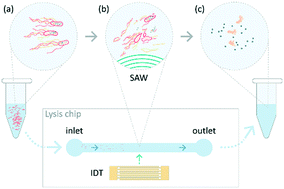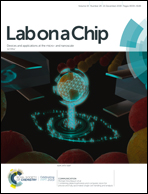Rapid additive-free bacteria lysis using traveling surface acoustic waves in microfluidic channels
Abstract
We report an additive-free method to lyse bacteria and extract nucleic acids and protein using a traveling surface acoustic wave (TSAW) coupled to a microfluidic device. We characterize the effects of the TSAW on E. coli by measuring the viability of cells exposed to the sound waves and find that about 90% are dead. In addition, we measure the protein and nucleic acids released from the cells and show that we recover about 20% of the total material. The lysis method should work for all types of bacteria. These results demonstrate the feasibility of using TSAW to lyse bacteria in a manner that is independent of the type of bacteria.



 Please wait while we load your content...
Please wait while we load your content...